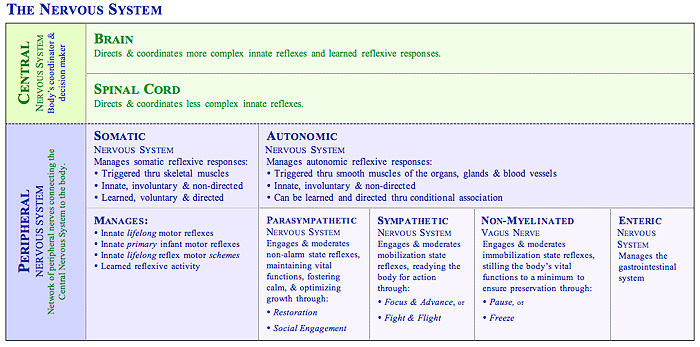
The Method
Reflex Physiology & the Nervous System
The reflex arc, as defined by Sir Charles Sherrington in the early 1900s, provides the simplest physiological explanation of how reflexive activity in the body works, specifically:
- Sensory system receptors (tactile, auditory, visual, olfactory, gustatory, vestibular, proprioceptive or viscera sensory neurons) detect a change in the environment
- A sensory neuron (also known as afferent nerve fiber) carries the sensory message through neural pathways to the central nervous system (spinal cord and or brain)
- The central nervous system interprets the sensory information and determines the necessary response
- A motor neuron (efferent fibers) carries the response message to the effector (skeletal muscle, non-skeletal
muscle, gland, organ or vascular pathway) responsible for generating the motor response - The effector generates the motor response
While a reflex unit as simple as the reflex arc is instructive, it is important to note that a reflex this simple cannot occur in isolation given the integrative nature of the human nervous system. The human nervous system is made up of two major subdivisions: the central nervous system and the peripheral nervous system. The central nervous system consists of the brain and spinal cord. This system acts as the coordinator and decision-maker for all conscious activity and manages or oversees all unconscious activity. The peripheral nervous system connects the brain and the spinal cord to the rest of the body through a complex network of ‘peripheral’ sensory, motor, and autonomic neural nerve bundles. The peripheral nerve system detects changes in the environment, notifies the central nervous system, and then carries out the response dictated by the central nervous system. In other words, the central nervous system assesses and directs much like a President of a company might, while the peripheral nervous system relays information and engages in action much like the President’s staff.
The peripheral nervous system is further divided into the somatic and the autonomic nervous systems. To further the analogy, the somatic nervous system acts as the President’s exterior staff, controlling the involuntary and voluntary responses relating to the body’s external environment through the striated muscles of the skeletal system, while the autonomic nervous system is like the President’s interior staff, controlling vital responses relating to the body’s internal environment through smooth muscles of organs, glands and the vascular systems. Motor responses that involve the striated muscles of the skeletal system are called somatic reflexes and motor responses that involve the smooth muscle of organs, glands, and the vascular system are called autonomic reflexes.
The somatic system is commonly attributed with managing voluntary, directed motor responses, and the autonomic system with managing involuntary, non-directed motor responses. While this characterization is accurate, it is incomplete, because the somatic system also manages a number of involuntary, non-directed reflexes involving the muscular skeletal system. Ivan Pavlov, for example, demonstrated that autonomic system responses, such as salivation, could be controlled through the process of conditional association.
Outlined below is the basic structure of the human nervous system.



